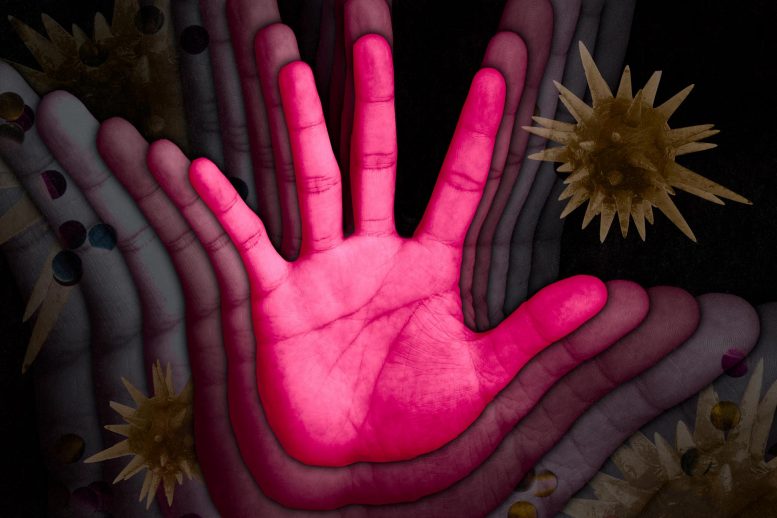
MIT neuroscientists have identified a brain circuit that stops mice from mating with others that appear to be sick.
When someone is sick, it’s natural to want to stay as far from them as possible. It turns out this is also true for mice, according to an MIT study that also identified the brain circuit responsible for this distancing behavior.
In a study that explores how otherwise powerful instincts can be overridden in some situations, researchers from MIT’s Picower Institute for Learning and Memory found that when male mice encountered a female mouse showing signs of illness, the males interacted very little with the females and made no attempts to mate with them as they normally would. The researchers also showed that this behavior is controlled by a circuit in the amygdala, which detects distinctive odors from sick animals and triggers a warning signal to stay away.
“As a community, it’s very important for animals to be able to socially distance themselves from sick individuals,” says Gloria Choi, an associate professor of brain and cognitive sciences at MIT and a member of the Picower Institute. “Especially in species like mice, where mating is instinctively driven, it’s imperative to be able to have a mechanism that can shut it down when the risk is high.”
Choi’s lab has previously studied how illness influences behavior and neurological development in mice, including the development of autism-like behaviors following maternal illness during pregnancy. The new study, which was published recently in Nature, is her first to reveal how illness can affect healthy individuals’ interactions with those who are sick.
The paper’s lead author is MIT postdoc Jeong-Tae Kwon. Other authors of the paper include Myriam Heiman, the Latham Family Career Development Associate Professor of Neuroscience and a member of the Picower Institute, and Hyeseung Lee, a postdoc in Heiman’s lab.
Keeping a distance
For mice and many other animals, certain behaviors such as mating and fighting are innately programmed, meaning that the animals automatically engage in them when certain stimuli are present. However, there is evidence that under certain circumstances, these behaviors can be overridden, Choi says.
“We wanted to see whether there’s a brain mechanism that would be engaged when an animal encounters a sick member of the same species that would modulate these innate, automatic social behaviors,” she says.
Previous studies have shown that mice can distinguish between healthy mice and mice that have been injected with a bacterial component called LPS, which induces mild inflammation when given at a low dose. These studies suggested that mice use odor, processed by their vomeronasal organ, to identify sick individuals.
To explore whether mice would change their innate behavior when exposed to sick animals, the researchers placed male mice in the same cage with either a healthy female or a female that was showing LPS-induced signs of illness. They found that the males engaged much less with the sick females and made no effort to mount them.
The researchers then tried to identify the brain circuit underlying this behavior. The vomeronasal organ, which processes pheromones, feeds into a part of the amygdala called the COApm, and the MIT team found that this region is activated by the presence of LPS-injected animals.
Further experiments revealed that activity in the COApm is necessary to suppress the males’ mating behavior in the presence of sick females. When COApm activity was turned off, males would try to mate with sick females. Additionally, artificially stimulating the COApm suppressed mating behavior in males even when they were around healthy females.
Sickness behavior
The researchers also showed that the COApm communicates with another part of the amygdala called the medial amygdala, and this communication, carried by a hormone called thyrotropin releasing hormone (TRH), is necessary to suppress mating behavior. The link to TRH is intriguing, Choi says, because thyroid dysfunction has been implicated in depression and social withdrawal in humans. She now plans to explore the possibility that internal factors (such as mental state) can alter TRH levels in the COApm circuits to modulate social behavior.
“This is something we are trying to probe in the future: whether there’s a link between thyroid dysfunction and modulation of this amygdala circuit that controls social behavior,” she says.
This study is part of a larger effort in Choi’s lab to study the role of neuro-immune interactions in coordinating “sickness behaviors.” One area they are investigating, for example, is whether pathogens might attempt to exert control over the animals’ behavior and stimulate them to socialize more, allowing viruses or bacteria to spread further.
“Pathogens may also have the ability to utilize immune systems, including cytokines and other molecules, to engage the same circuits in the opposite way, to promote more engagement,” Choi says. “This is a sort of far-flung, but very interesting and exciting idea. We want to examine host-pathogen interactions at a network level to understand how the same neuro-immune mechanisms can be differently employed by the host versus pathogen to either contain or spread the infection, respectively, within a community. For example, we want to follow sick animals through their interactions within the community while controlling their immune status and manipulating their neural circuits.”
Reference: “An amygdala circuit that suppresses social engagement” by Jeong-Tae Kwon, Changhyeon Ryu, Hyeseung Lee, Alec Sheffield, Jingxuan Fan, Daniel H. Cho, Shivani Bigler, Heather A. Sullivan, Han Kyung Choe, Ian R. Wickersham, Myriam Heiman and Gloria B. Choi, 31 March 2021, Nature.
DOI: 10.1038/s41586-021-03413-6
The research was funded by the National Institute of Mental Health, the JPB Foundation, the Simons Center for the Social Brain Postdoctoral Fellowship program, and the Picower Fellowship program.